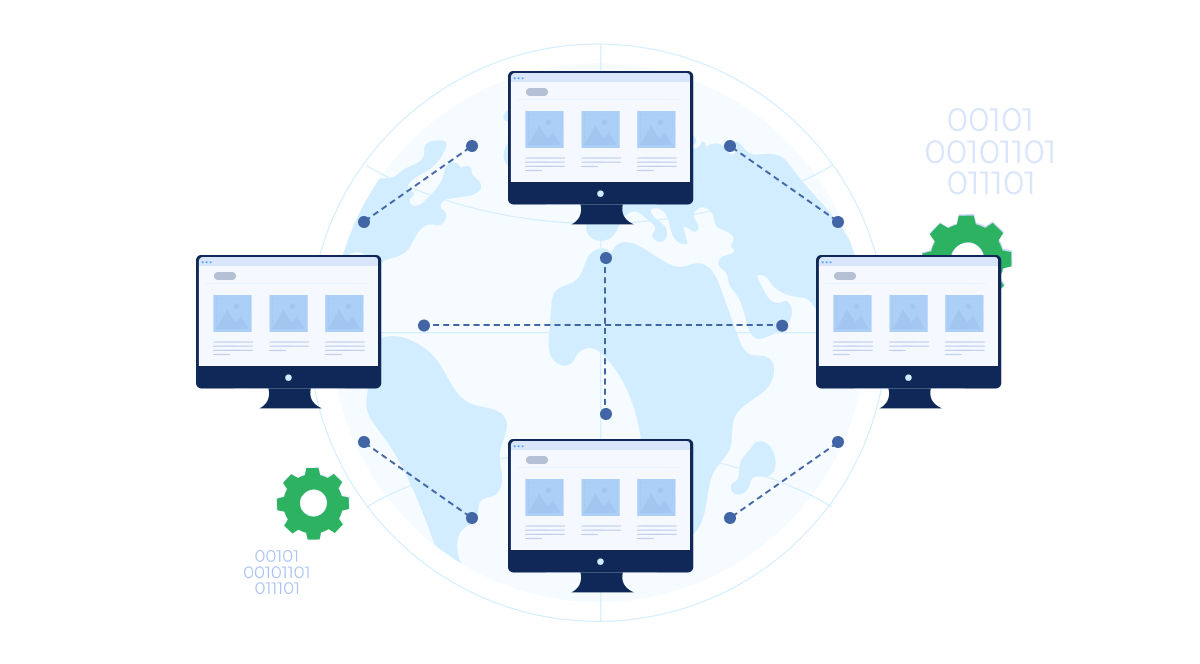P2P is an efficient method of transferring data over the Internet. The best-known example of a P2P network is torrent.
In peer-to-peer networks, the term “peer” refers to a separate computer or device that is connected to other devices over the Internet. Peer-to-peer networks are abbreviated as P2P. A distinctive feature of a peer-to-peer network is that it does not require a separate server to maintain communication. With P2P, you can exchange any data between any devices within the network. Moreover, each device can act as a server and a client, depending on its role.
 Connection Methods
Connection Methods
There are three methods to connect peers in a P2P network:
- USB
- Wires or wireless connection
- Protocols
USB is used to connect two computers for data exchange. However, for a larger number of systems, cables are a more efficient means of data transfer. The purpose of the protocols is to connect and manage different types of devices that are connected to the Internet.
How Does P2P Work?
Basically, the purpose of P2P networks is to share resources and jointly maintain the functioning of systems, provide certain services, or perform certain tasks. However, P2P is most commonly used for data exchange on the Internet. Peer-to-peer networks are well suited for file sharing because they allow simultaneous reception and transfer of files to connected computers.
When a client wants to download a file or application over the Internet, it opens the corresponding website. In this case, the website acts as a server, while the operator of the website is the client. This structure works like a one-way street where data is transferred from point A (website) to point B (client device).
However, in the case of a P2P network, when clients need to download data of a similar nature, the scheme is completely different. Here, a virtual network is created based on the P2P application installed on the PC. When a user issues a command to download a file, it is received by all devices connected to the network that contain the desired file. In this case, the process can be represented as a two-way street, where data is converted into small fragments coming from the user’s device.
P2P Architecture
P2P is often used in addition to data networks because each device and other peers in this structure have the same capabilities. For small networks, such as a private home or a small office, a P2P network is very suitable because each device serves as an autonomous working environment and can store all data on its hard disk.
The P2P platform is built to use a single software application, where each part of the program performs certain actions both as a client and as a server with the same capabilities.
Types of P2P
1. Pure P2P network:
This type of P2P network is used instead of a dedicated server and implies that all peers have the same role.
2. Unstructured P2P network:
An unstructured P2P network facilitates users to connect to other devices. In this type of P2P network, all systems have their own role, but due to the lack of structure, it can be difficult to find a specific file.
3. Structured P2P network:
Unlike an unstructured P2P network, a structured network is difficult to set up. However, this network provides users with effective access to search rare contents in the network.
4. Hybrid P2P network:
The operation of a hybrid P2P network is similar to that of a client-server network. In this type of network, a central peer is defined to perform various actions that are normally performed by the server. It stores all the information about the connected system and responds to queries requesting this specific information.
Pros & Cons
The main advantages and disadvantages of P2P are briefly presented in the table below:
| Advantages (+) | Disadvantages (-) |
| No special operating system required | The network is decentralized |
| No well-trained personnel are required to manage the network | Lack of a central storage medium |
| There are no requirements for a specific administrator | Performance problems may occur |
| Simple configuration | Since data may be stored on multiple devices, it may be difficult to back it up |
| No expensive server required | A large amount of copyrighted content is distributed without any permission |
| Scalable | Users can access any kind of files from another computer without any permission |
| Constant availability | Special software, such as torrent, is required to access or download files |
| Simplified search process | There is no possibility to preview the file before the full download |




















